Declan Kerin and Anthony Petrielli contributed to this report.
Nazem Kadri: A
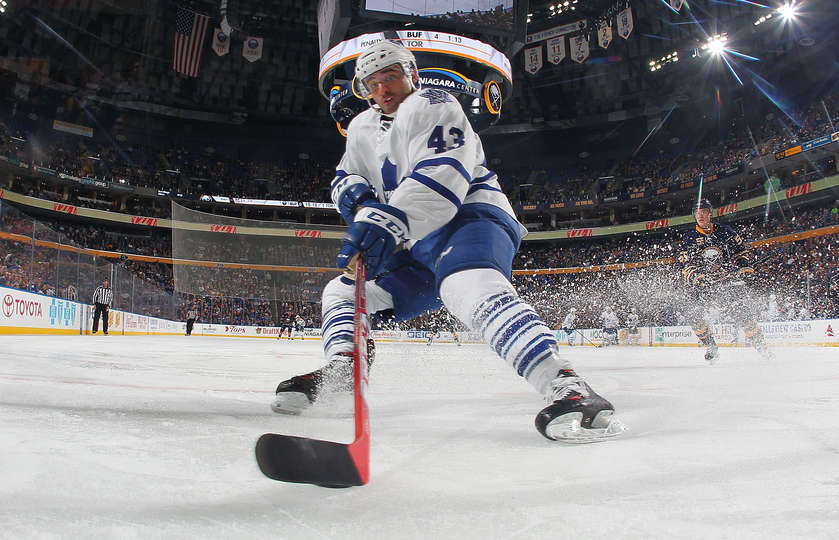
| GP | G | A | PTS | +/- | PIM | EV | PP | SH | GW | S | S% | ATOI | FO% |
|---|---|---|---|---|---|---|---|---|---|---|---|---|---|
| 20 | 8 | 7 | 15 | 0 | 45 | 7 | 8 | 0 | 1 | 52 | 15.4 | 15:46 | 44.7 |
Offensively, the start of Kadri’s season couldn’t be any more of a contrast to his start to last season. The most cursed man in hockey after scoring one goal on his first 81 shots of 2015-16, Kadri has eight goals on 52 to kick off his 2016-17 campaign. Partially that’s down to straight-up puck luck, partially it’s thanks to improved talent around him — William Nylander has replaced Michael Grabner (the 2015-16 version that couldn’t finish to save his life) on his right wing on the road, Connor Brown at home — and the other part is Kadri settling more comfortably into the matchup center spot with almost a full year of experience in the role now under his belt. Fresh off a new six-year contract extension, the 26-year-old is off to the best goal-scoring start of his career (eight in 20).
The offensive gains have come while occupying the most important forward role on the team and holding his own in the run of play. He’s breaking even with a 0.1 Corsi For relative to his teammates despite starting 38.3% of his shifts in the defensive zone (tied for second on the team with linemate Leo Komarov among Leaf regulars behind Ben Smith) and drawing the top center matchup nearly every game. He’s had to steal his fair share of the limelight away from the exciting young talent on the Leaf roster, and has successfully done so with some notable nights up against the likes of Connor McDavid and Aleksander Barkov. Kadri appears to enjoy the challenge and subsequent attention when a star name comes into town with the opposition.
He will cool off offensively given he’s currently shooting 15.4% against a career average of 10.8 — while he’s a skilled finisher in tight, his shot grades as average at best — but that’s more than fine if can continue to chip in while limiting the damage inflicted by the opposition’s top forward line. He’s a natural competitor who doesn’t shy away from physical contact/confrontation — even against much larger opponents. Over the past two seasons, he has started to take great pride in keeping the league’s best players off the scoresheet just as much as he does in putting up points of his own. He’s not an elite two-way center in the category of a Patrice Bergeron, but he has successfully adapted to and embraced a vital role that allows the likes of Matthews, Nylander and Marner to learn the league in lighter, more offensive roles.
Mitch Marner: A-
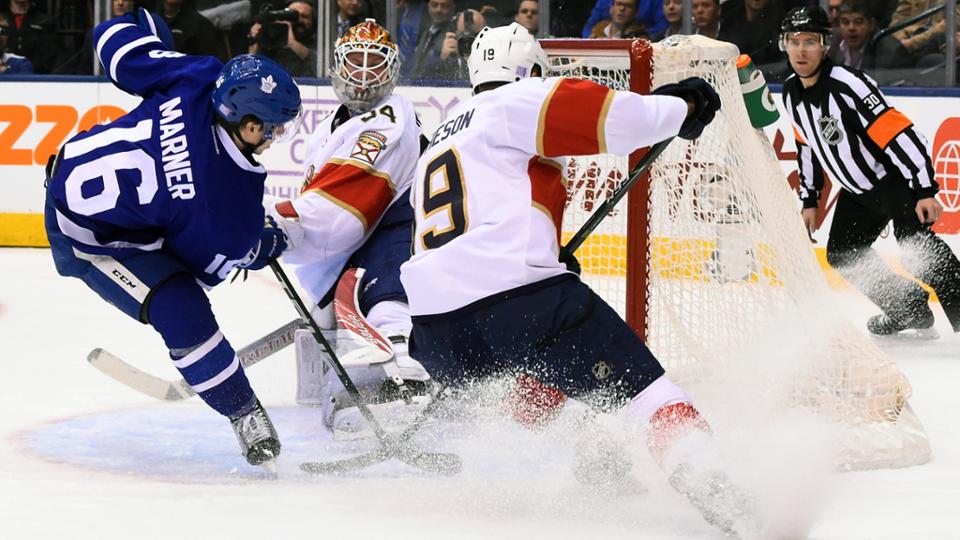
| GP | G | A | PTS | +/- | PIM | EV | PPP | SH | GW | Shots | S% | ATOI | FO% |
|---|---|---|---|---|---|---|---|---|---|---|---|---|---|
| 20 | 7 | 9 | 16 | -4 | 14 | 13 | 3 | 0 | 3 | 56 | 12.5 | 16:44 | 50 |
There was no shortage of fans and pundits who thought Marner was too good for the OHL but not quite ready for the rigors of the NHL game. He was often described as the poster boy for the “in-betweener” player, a frustrating consequence — from the player and the NHL team’s perspective — of the CHL-AHL agreement. In fairness, it was hard to blame anyone for questioning how much of the magic Marner regularly produced at the OHL level was realistically transferable onto the NHL stage. The answer, as it turns out, is “a good amount.”
While much of the fan base spent a summer debating the inches and pounds required for Marner to crack the NHL full time, President Brendan Shanahan and head coach Mike Babcock redirected attention to the overriding importance of “hockey strength” and were encouraged by how Marner’s was coming along. A year after he looked a little timid and overwhelmed in his first NHL camp, it was clear from the first preseason game that Marner was ready to take 2016 by storm. He had clearly gained a step — “legitimately fast by NHL standards,” as far as his top gear is concerned, is now a fair description in addition to the quickness and elusiveness that was always there. Fast forward a month and a half into the season, concerns about his size have been all but dismissed and fans and pundits have been unanimously awestruck by his offensive abilities and the maturity of his all-around game.
While he went pointless in game one, he put six shots on goal in the opener and it was apparent to anyone watching that the 19-year-old former Knight was ready to hit the ground running. It was instantly clear that Marner is on a different level mentally and creatively than the majority of players in the league. He is making something happen out of dead plays with regularity and is showing an ability to shift back and forth from forwards to backwards skating on offence that is not often seen at any level of the game. His vision and hockey sense — and his ability to manipulate and cross up the feet of even the most experienced NHL defencemen — belie his age. While he didn’t look substantially bigger than when we last saw him in the Memorial Cup the previous May, the fearlessness and slipperiness have been there from the get go. He’s showed little hesitance about driving the net, using his strength on his edges and an advanced awareness of how to use leverage to beat bigger opponents.
After three points in his first six games, Marner is up to 16 points in 20, only three of which have come by way of the powerplay. His 16 points overall are tied for second in rookie scoring with Matthews and tied for second on the Leafs, while his 13 even-strength points lead all first-year players. His possession numbers are near the bottom among Leaf forwards, but it could be fairly argued without much bias in favour of the new kid that Marner has been the least of the problems on his line as far as his play away from the puck, as we’ll discuss more in the Bozak and JVR writeups below.
Auston Matthews: A-

| GP | G | A | PTS | +/- | PIM | EV | PP | SH | GW | S | S% | ATOI | FO% |
|---|---|---|---|---|---|---|---|---|---|---|---|---|---|
| 20 | 8 | 8 | 16 | -3 | 0 | 10 | 6 | 0 | 0 | 75 | 10.7 | 17:26 | 49.3 |
20 games in, Leafs fans are still pinching themselves to confirm they’re awake/alive when they see the 19-year-old phenom don the Blue and White. A did-that-just-happen start to his NHL career saw him make history with four goals in his first ever NHL game in the Leafs’ home-away-from-home in Kanata with his mom overwhelmed to the point of tears in the stands — a moment that is unlikely to be topped this season. Six goals and ten points in his opening six games saw him jostle for top spot early in the NHL scoring race, never mind the rookie scoring race. He returned to Earth — somewhat — with a lengthy slump that was only recently laid to rest, but he remains sixth in the entire league in scoring chances and eighth in shots on goal. On pace for a 33-goal, 66-point rookie season while already having experienced a significant slump (0 goals, 3 assists in 13 games), he’s also shooting a relatively low 10.7% for a player with his calibre of shot. As a point of reference, the top 50 NHL points scorers last season averaged a 12.8% shooting percentage. Matthews certainly has the ability to be a 13+% shooter as many of the game’s consistent goal scorers are. Matthews is the real deal and an absolute franchise changer — of that there is no doubt. Everything about his first 20 games — from his overall numbers to his insane start, to his frustrating slump that he fought his way through by bearing down and shooting, shooting and shooting some more — suggests he’s well on his way to becoming a superstar in the league.
While he has started on a “sheltered line”, it should be noted that he’s also done this flanked by two other rookies, which is highly unusual for a rookie center entering the NHL. It’s also become commonplace in the NHL to mix in even highly-skilled young centers on the wing of veteran lines to acclimate them to the 200-foot demands of the league (sometimes for the majority of their rookie season). It’s telling that Mike Babcock has avoided that route altogether with Matthews, who has spent nearly every second of his ice time at center and has drawn the attention of top opposition centers and defence pairs on the road.
Despite manufactured controversy and hyperbole surrounding his slump — or feigned controversies; i.e., “this big deal that everyone is trying to make out to be a big deal isn’t actually a big deal” — he came out the other side stronger for it.
William Nylander: B+

| GP | G | A | PTS | +/- | PIM | EV | PP | SH | GW | S | S% | ATOI | FO% |
|---|---|---|---|---|---|---|---|---|---|---|---|---|---|
| 20 | 6 | 9 | 15 | -4 | 6 | 6 | 9 | 0 | 0 | 50 | 12 | 16:11 | 44.7 |
The forgotten one, William Nylander, has largely been the third wheel in the trio of high-end talent the Maple Leafs have brought into their system, after Matthews and Marner. Even after receiving the rookie of the month nod in October — the first time in 20 years that a Maple Leafs skater has been awarded the honour.
Through our game reviews to start the season, we argued that he was the best of the three young talents in several games, bringing some elements we normally didn’t see from him due to the fact that he has traditionally played center throughout his career. When forechecking as a winger, he showed some real skill at hurrying defencemen to make plays they weren’t ready to make, causing turnovers or steering plays away from normal break-out patterns (largely unnoticed by the broadcast crews), and creating havoc for the other team — this all falls under the definition of “play away from the puck.” Combine it with his pick-pocketing abilities — a skill the trio of rookies all share — and he’s become a terrifying forechecker to turn the puck over to. Not in the glass-rattling way we’ve come to know as effective forechecking, but more in the — dare we say — Dave Keon mould.
Defensively, Nylander has been the first forward back as much or more than his linemates and has often performed the duties of a centerman. Perhaps he’s looking to prove to Babcock he can play center as well as Matthews can, or perhaps he’s just defaulting back to a natural position, but it serves as a reminder that Nylander is viable replacement at center in the not-too-distant future.
Being tied at the hip on a line with Matthews meant some spells of quiet offence from both players simultaneously, although Nylander hasn’t gone more than three games without a point after 20 games. He did have a nine-game scoreless streak that certainly ground away at the 20-year-old, despite the dominance of his line on many shifts most nights. Nylander had 11 points in his first 10 games followed by four points in his next 10, but the chances were there: Nylander is ranked second among forwards with a 52.7 share of possession when he’s on the ice, just behind Matthews. Defensively, in terms of shot suppression — despite what some in the media and fan base try to drum up as far as Nylander being a poor defensive player — there’s virtually no empirical or hard data to back up these narratives. He is certainly far from perfect defensively and sometimes needs to remember to finish off his last three strides coming back defensively — as well as dig in more on his second and third battles — but he’s 20 and his road to learning the pro game under a defensively-demanding coach will be a long one. Nylander has had a brilliant start to his NHL career and he is perhaps the most naturally-gifted athlete on the team. In a market that likes to consider itself a sophisticated hockey town, there’s been some very unsophisticated commentary surfacing around this player lately.
Remember: effortlessness =/= no effort.
Connor Brown: B+
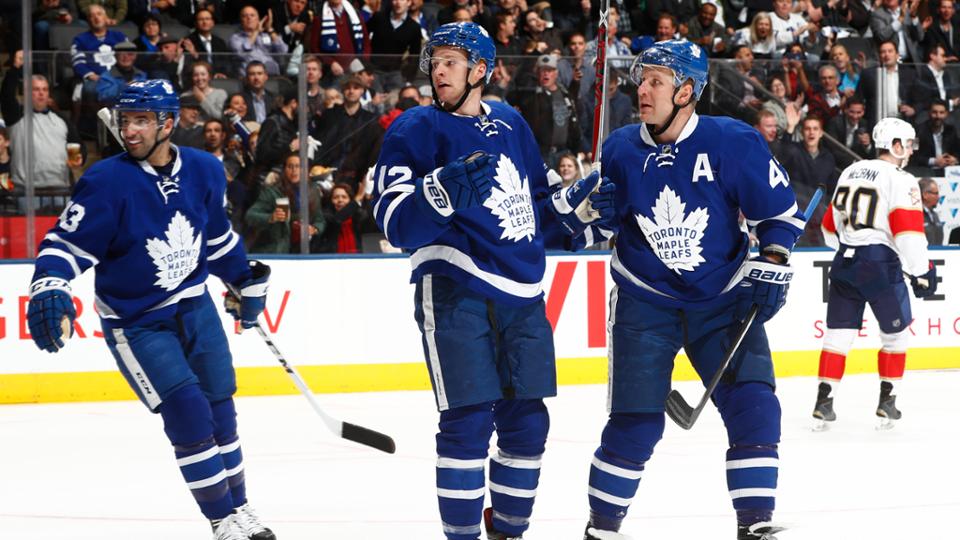
| GP | G | A | PTS | +/- | PIM | EV | PP | SH | GW | S | S% | ATOI |
|---|---|---|---|---|---|---|---|---|---|---|---|---|
| 20 | 3 | 5 | 8 | 4 | 4 | 8 | 0 | 0 | 1 | 29 | 10.3 | 14:03 |
After starting the year on the fourth line while the Maple Leafs front office and coaching staff sorted through what to do with the veteran deadwood on the roster, Brown formed what could arguably be described as one of the most effective fourth lines the club has had in a decade (Martin – Holland – Brown). With Milan Michalek sent to the Marlies, a hole was punched in the lineup for Brown to move up onto a line with a skilled left-shot center in Kadri. It’s a tall order for a rookie to play against the best players in the league, but with his experience in a similar role on the Marlies the past two seasons — along with consistent penalty kill usage — it wasn’t as much of a leap-of-faith from the coaching staff as one might think.
A coach’s pet, Brown has a faultless work ethic and has displayed excellent underlying skill in every league he’s played in. With an added step to his skating — along with some dynamism added to his game through successive crossovers, and a newly-learned skill wherein he uses elusiveness to control a defender’s feet and force him to turn prematurely — Brown is enjoying more room in which to play and think to go along with good puck retrieval skills and a nose for the net.
Brown got off to a slow start with a meagre two points through his first 15 games (one goal versus the Boston Bruins and one assist versus the Edmonton Oilers), but he has come on a lot stronger of late with six points in his last five games, including a breakout performance with two goals and two assists versus the Florida Panthers. Brown has been taking shifts with Matthews on the road — switching in for Nylander — and has been invigorated by the opportunity (although the four-point Florida game was at home next to Kadri).
Brown is on pace for a solid 12-goal, 33-point rookie campaign despite the slow production to start the year (he’s shooting 10.3% overall against a league average of 10.6% among forwards). That could start to creep up as the season progresses.
The Maple Leafs have a sixth-round gem here in Connor Brown, to the surprise of no one who has followed his hockey career closely to date.
Zach Hyman: B
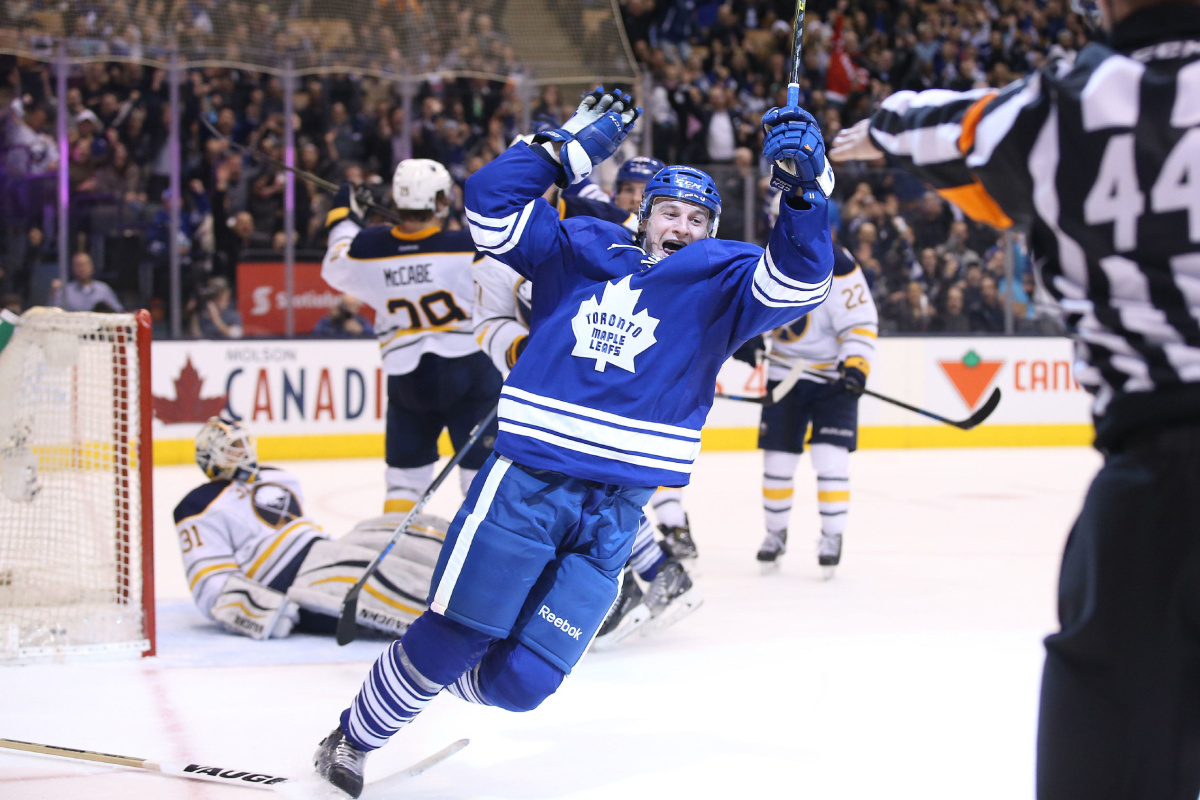
| GP | G | A | PTS | +/- | PIM | EV | PP | SH | GW | S | S% | ATOI | FO% |
|---|---|---|---|---|---|---|---|---|---|---|---|---|---|
| 20 | 2 | 3 | 5 | -3 | 6 | 5 | 0 | 0 | 1 | 42 | 4.8 | 16:28 | 36.8 |
Zach Hyman has been a bit of a divisive player so far this season; most fans would agree that they like his game and regard him as a useful contributor, but the divide centers around his current role on a line with two highly-skilled youngsters in Auston Matthews and William Nylander (or occasionally Connor Brown, of late).
Hyman’s tireless work ethic is rivalled by only Brown and Leo Komarov among the forward group. He’s a north-south player who skates fast in straight lines and retrieves pucks, and he’s willing to drive the net to create space and offensive opportunity for his linemates. That bears out in his even-strength possession numbers — he has a 52.6% Corsi For with a 3.5 CF relative to teammates on the Leafs’ best possession line with Matthews and Nylander. He’s the team’s leading penalty killing forward as well, playing 2:43 in shorthanded ice time per game, and is tops among the Leafs’ regular penalty killing forwards in 4v5 Corsi Against per 60. Part of what makes him so good on the PK is his ability to pressure teams up ice and prevent clean entries as he reads the play and disrupts powerplay breakouts.
We do have to question why his complementary skillset hasn’t translated into more points on the scoresheet when he’s played significant minutes alongside Matthews and Nylander. He recently quieted the criticism somewhat with a two-point game against New Jersey opposite Connor Brown on Auston Matthews’ line, but five points in 20 games — a 21-point pace over 82 — strikes many as underwhelming given his placement in the lineup. Limited in terms of his puck skills to begin with, Hyman is also playing his off-wing as a right-hander on the left, making it especially difficult to send and receive passes to and from his superbly skilled linemates. It also often forces Hyman to dump the puck in as a default when he’s the carrier through neutral ice.
Leo Komarov: B
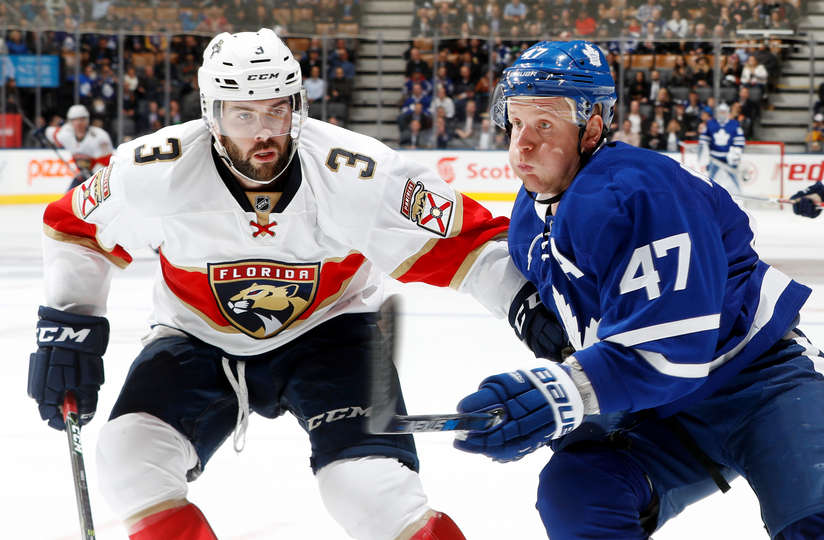
| GP | G | A | PTS | +/- | PIM | EV | PP | SH | GW | S | S% | ATOI | FO% |
|---|---|---|---|---|---|---|---|---|---|---|---|---|---|
| 20 | 3 | 5 | 8 | 2 | 9 | 5 | 2 | 1 | 0 | 23 | 13 | 17:13 | 46.8 |
The utilitarian winger returns in the “matchup” role on Kadri’s wing and is again playing a significant part on the team in all game situations. A sluggish offensive start saw him begin the season with just two points in the first 11 games, but he’s quietly amassed three goals and six points in his last nine dating back to the Vancouver game. He’s playing 17:13 per night through 20 games with around two minutes a game on average on both sides of special teams. The 29-year-old has posted a 48.5% Corsi For (-1.6 CF RELTM) but with the second highest defensive zone start percentage (38.3) among Leaf regulars, behind only Ben Smith, while playing against top competition at even strength every night. Komarov is on pace for his customary 275+ hits, along with 12 goals and 33 points. He’s again been good value for his initially-controversial contract, but he has not been quite the same Uncle Leo we’re used to seeing in terms of agitating the opposition — at least so far. He’s also playing his usual physical game, for the most part, without costing his team with poor discipline, so it’s a fine balance — one that Komarov, save for a three-game suspension for a hit on Ryan McDonagh in February of last season, has proven quite adept at navigating.
Komarov is on pace for under 100 shots in 82 games currently (95-shot pace compared to 135 last season), so he’ll need to get his shot rate up and make himself more of a factor in front of the opposition’s net, where he’s been less noticeable this season than last.
Tyler Bozak: B-
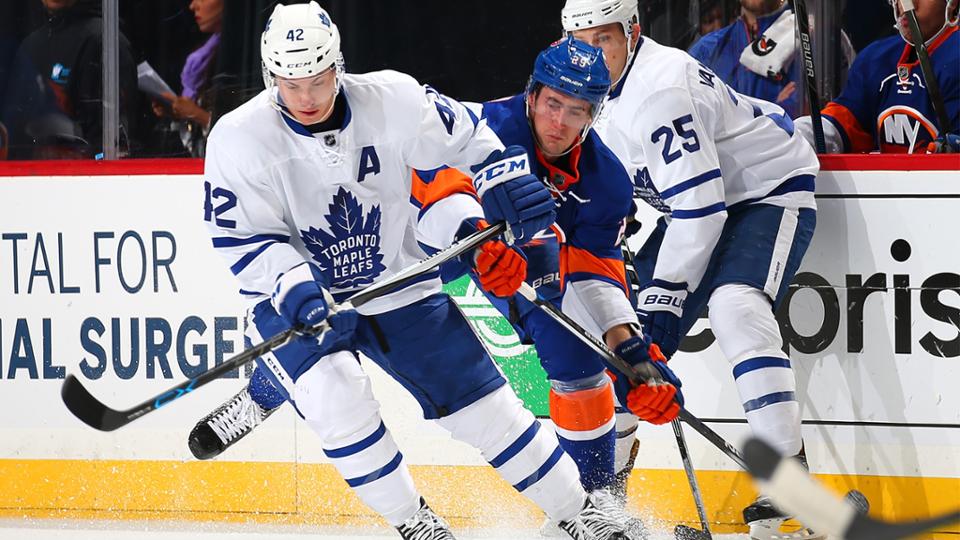
| GP | G | A | PTS | +/- | PIM | EV | PP | SH | GW | S | S% | ATOI | FO% |
|---|---|---|---|---|---|---|---|---|---|---|---|---|---|
| 20 | 5 | 9 | 14 | -2 | 4 | 12 | 2 | 0 | 1 | 34 | 14.7 | 16:08 | 57.9 |
Relieved of the burden of having his lineup spot constantly questioned while serving as the de-facto 1C next to Phil Kessel, Bozak has seen his usage lightened and minutes reduced under Babcock, settling into a #2 or #3 center role, depending on who you ask. The Maple Leafs — and Bozak — are better off for it. He’s landed on his feet alongside his usual potential 30-goal-scoring left-winger in James van Riemsdyk (JVR) and one of the most electrifying rookies to enter the league on his right wing in Mitch Marner.
The line does not fare well from a possession standpoint on too many nights, mostly due to JVR and Bozak’s inability to steal pucks back anywhere but in the offensive zone, stop or disrupt plays with pressure and/or good stick detail, along with more than their fair share of slack efforts on the backcheck. Marner is often performing the duties of the centerman, covering both wings to fix the mistakes of his veteran linemates and quickly turn them into rush-attack chances in transition. That’s helped make Bozak – and the entire line — look better than they are defensively, at times.
At 30 — going on 31 — Bozak is what he is at this stage: A productive middle-six scoring center. Despite being billed as a strong defensive center earlier in his career, the stats have never backed up the label. Regardless of who Bozak plays with, he leaks shots/shot attempts against most of the time he’s on the ice. The aforementioned poor stick detail comes in many forms: Bozak will sometimes spend entire defensive zone shifts with his stick at waist-level with only one or two hard strides mixed in here or there. He also regularly lets pucks go through him in the offensive and neutral zones as he opens up the defensive triangle to try to pick off passes using his timing and coordination. That doesn’t always go as planned, and — on top of that — it doesn’t allow him to deter plays from opponents through looking engaged defensively and directing the flow of play as the centerman.
Bozak has many redeeming qualities as a sneaky, opportunistic offensive player, to go along with being a valuable right-shot centerman who is very good on the faceoff dot. He’s winning nearly 58% of his draws a quarter of the way into the season (17th in the league) with some assistance from his spark-plug wingmate in Marner and to a lesser degree JVR. Bozak has enjoyed an offensive rejuvenation alongside Marner. While he was trying too hard to play like Marner in the early going — making overly fancy, low-percentage passes resulting in turnovers — he has settled in and started to learn how and where Marner wants the puck. The line is now starting to achieve some excellent offensive results.
Highlighted by a career-high mark of four points in a game en route to a blowout win over the Nashville Predators, Bozak is up to 14 points in 20 games — a 21-goal, 57-point pace over 82. That’s a more impressive pace when we consider that just 14% of his points have come by way of the powerplay (two of 14) compared to a 27% average over his career (75 of 281).
Bozak has often flirted with the 50-point plateau throughout his career but has never managed to achieve the benchmark. Maybe — with a special young talent on his right wing and the reliable production of JVR on his left, while playing a sheltered offensive role — this is finally the season Bozak breaks down the barrier. His last four-game segment includes zero points and just one shot on goal, however.
James van Riemsdyk: B-

| GP | G | A | PTS | +/- | PIM | EV | PP | SH | GW | S | S% | ATOI |
|---|---|---|---|---|---|---|---|---|---|---|---|---|
| 20 | 8 | 9 | 17 | -2 | 8 | 14 | 3 | 0 | 1 | 58 | 13.8 | 15:34 |
Our understanding of the strengths and limitations of JVR’s game has not changed much from last season. He’s a safe bet for 25-30 goals and 55-60 points, with the potential for a little more in the right situation. As Anthony Petrielli put it in a recent notebook, “He’s a legitimate top six scoring winger with size in a league where just about everyone covets scoring and size.” He is off to a productive start with 17 points in 20 games (tops on the team), a pace that would leave him with a career-high 33 goals and 70 points if sustained. With JVR healthy again, him and Bozak have resumed their kinship offensively while rookie sensation Mitch Marner has hopped aboard their right flank and made the ice bigger for the duo with his vision, playmaking abilities and knack for sucking in defenders before finding his linemates in space.
Marner also takes care of a disproportionate amount of the puck-hounding and backchecking responsibilities for a player with 20 games of NHL experience compared to JVR and Bozak’s 921 combined. Even if the production hasn’t been, the consistency to JVR’s efforts feels uneven watching him day to day; his intensity wavers from shift to shift and game to game, which bears out in the underwhelming possession numbers. On too many nights it’s rare to see JVR win a puck battle anywhere outside of the offensive zone, and on many of those same nights it’s common to see JVR coast from the red line in on the backcheck.
JVR started a little slow to the eye — he was a little sluggish and behind the pace, perhaps due to his long injury layoff and lack of NHL game action in 2016 — but is now up to speed and producing fantastic numbers in a sheltered scoring role at even strength along with his usual duties as the powerplay net-front presence; even if it’s an off night for JVR, he usually gets a chance or two there. JVR has collected 14 of his 17 points — and all eight of his goals — at even strength this season, or 82% of his offense compared to 71/29 ratio over his previous four seasons in Toronto (he is also playing 29 seconds less per game on the powerplay compared to 2015-16). He is currently shooting 13.8% against a career norm of 10.9%, but if he can make up for the natural regression with more powerplay production going forward, a career season is not out of the question.
With his contract due up in 2018, strong production from JVR is only going to continue to spur discussion about his future in Toronto and whether the time to move the 27-year-old — specifically to address a need on the blueline — is sooner than later. But that’s the subject for another article.
Nikita Soshnikov: C+

| GP | G | A | PTS | +/- | PIM | EV | PP | SH | GW | S | S% | ATOI |
|---|---|---|---|---|---|---|---|---|---|---|---|---|
| 11 | 1 | 2 | 3 | 1 | 4 | 3 | 0 | 0 | 0 | 13 | 7.7 | 9:05 |
Injured — beneath the surface, anyway — to start the season, Soshnikov was pulled from training camp in order to build up strength in an area of his legs showing signs of weakness, as per the analysis of the Leafs’ sports science department:
“He had an imbalance between his quad strength and his hamstring strength, so what we have done is we have basically shut him down to get his hamstring strong enough so he is not getting hurt all the time,” Head Coach, Mike Babcock said.
“It’s an issue for him and he is progressing very well. Because he has missed camp, he is going to have to start with the Marlies.”
Playing on a line with Frederik Gauthier and Kasperi Kapanen, Soshnikov was called up from the Marlies at the behest of Lou Lamoriello, who liked what he saw from Soshnikov after he returned from rehabbing a potential injury.
It’s not hard to notice Soshnikov. He plays with a general disregard for his physical well-being and is fearless about driving the net. He pairs an urgent game with good underlying skills — a hard, quick release, as well as good hands in tight. The free agent signing out of Russia is having difficulty gaining traction in the lineup playing alongside Ben Smith; Smith is a right-shot and Soshnikov is a left-shot playing the right, so their ability to play catch is limited. Not helping matters: Smith is probably an AHL-calibre player (at 5v5) at this stage.
Babcock has intimated that he needs to get Soshnikov more playing time higher in the lineup, but he has yet to pull the trigger on putting him in the obvious spot on a line with Matthews – Nylander at home and Matthews – Brown on the road. While Hyman is a tremendous worker and skates well in straight lines, Soshnikov would be able to play his correct side and provide similar puck retrieval results while adding the ability to jump in and out of holes, more overall puck skills, finish, and physicality to the line.
Soshnikov played higher in the lineup at the end of last season on a line with Kadri and Komarov and performed capably in that top-six role — especially for a rookie.
Matt Martin: C-
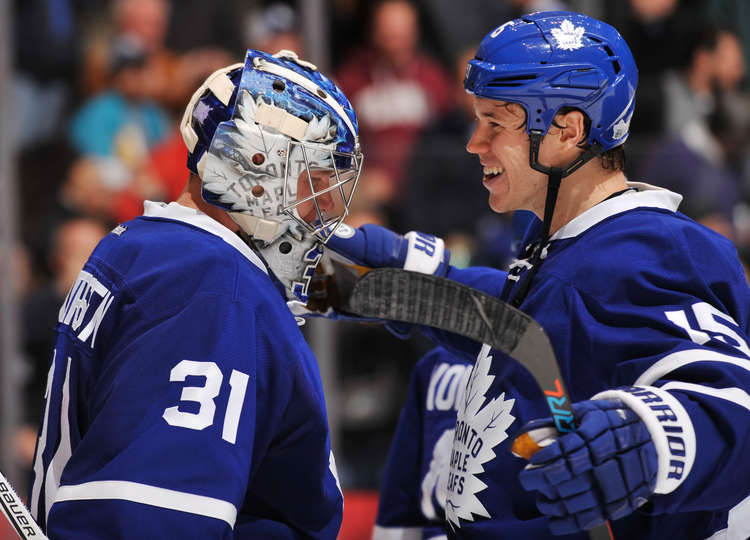
| GP | G | A | PTS | +/- | PIM | EV | PP | SH | GW | S | S% | ATOI |
|---|---|---|---|---|---|---|---|---|---|---|---|---|
| 20 | 1 | 2 | 3 | 0 | 41 | 3 | 0 | 0 | 0 | 19 | 5.3 | 10:02 |
Martin has come more or less as advertised, provided your expectations for him were properly adjusted coming into the year. He takes a shift on the fourth line, he’s physical, he mixes in the odd fight, and he will contribute offensively once every 10 games or so. Everyone knew he was overpaid the second he was signed and he hasn’t done much to dispel this notion. He’s playing 10:01 per night, so far, and the team has tried to get him involved in the penalty kill, as well, where he plays 1:07 each game on average. There was some thinking among the fan base in the summer that he would move up the lineup on the odd occasion to add some physicality/net presence to a skilled unit, but that has not happened yet at any point. At 5v5, he’s generally been snowed under with a 46.5 Corsi For percentage, but he’s a 50 CF% without Ben Smith, and he generally looked good on a cycle with Peter Holland and Connor Brown to start the year (50 CF% with Holland, 50.5 CF% with Brown). The fair bet is that Martin wouldn’t be getting hemmed in his zone nearly as much with a regular NHL center. It won’t make the $2.5M/year worth it, but he’s at least serviceable on that line — beyond whatever value one may or may not place on having an enforcer to “protect” an extremely young lineup.
Ben Smith: D
| GP | G | A | PTS | +/- | PIM | EV | PP | SH | GW | S | S% | ATOI | FO% |
|---|---|---|---|---|---|---|---|---|---|---|---|---|---|
| 14 | 1 | 1 | 2 | -2 | 0 | 2 | 0 | 0 | 0 | 12 | 8.3 | 11:45 | 53.4 |
Having signed in Colorado after endearing himself to Mike Babcock and his coaching staff at the end of last season, Smith was promptly claimed by the Leafs off of waivers and placed back on the team’s fourth line. A right-handed center who gives the Leafs two righties (along with Bozak) and two lefties (Kadri and Matthews) down the middle, Smith is filling an energy/PK role but is struggling within it. In 14 games, he has one goal, one assist and 11 shots on goal to go along with a 53.63 faceoff percentage. He’s playing 12 minutes per night, which is too high for that kind of production, although it’s worth noting he’s playing a little over two minutes of it on the PK each night. Smith is bottom on the team with 40.7 Corsi For percentage; some of that is due to his team-high 44.3 defensive zone start percentage as he is leaned on by Babcock for his draw-taking abilities before returning to the bench, but the mark only goes up to a 45-46% CF when on the ice with Nikita Soshnikov and Matt Martin.
Peter Holland: N/A
| GP | G | A | PTS | +/- | PIM | EV | PP | SH | GW | S% | ATOI | FO% |
|---|---|---|---|---|---|---|---|---|---|---|---|---|
| 7 | 0 | 1 | 1 | -2 | 4 | 1 | 0 | 0 | 0 | 0 | 10:52 | 46.4 |
After a determined effort in training camp and preseason that took him from probable waiver bait to the opening-night 4C, the early results alongside Matt Martin and Connor Brown were promising. The trio managed to break even in possession most nights — Holland was a 52.7% Corsi For in his 44 even-strength minutes alongside Connor Brown, while Matt Martin was a 50% CF in his 56 5v5 minutes alongside Holland (that drops to 43.5% CF away from Holland, with Ben Smith taking over the 4C role). While Brown deserved his promotion up the lineup, it had the makings of an above-average fourth line before the Smith waiver claim and the decision to relocate Brown to the Kadri line. When he’s not producing much in the way of offense, it’s crystal clear by now that Mike Babcock has little to no patience for Holland. While he’s made an effort to improve in this area, physical play does not come naturally to the 25-year-old center and Babcock feels he cannot rely on him in the defensive zone and penalty killing situations. Holland collected just one assist in his opening six games before he became a regular healthy scratch following the addition of Ben Smith, but his 3.33% 5v5 on-ice shooting percentage was a team-low, suggesting a lack of puck luck early on despite his line’s ability to tilt the ice in its favour (it’s more impressive when we look at his defensive zone starts — nearly as high as Ben Smith’s at 43.9%). Seemingly, the only way Holland is going to return to a regular role this season is if the Leafs run into injury troubles up front — if he even sticks around. Right now, he’s taking up one of 23 roster spots while GM Lou Lamoriello and cap manager Brandon Pridham shift paper around to keep Josh Leivo off of waivers. Something will have to give.



![Sheldon Keefe on the Maple Leafs’ struggling power play: “[We’ve scored] one out of 11 high-danger chances in tight to the net… We have been in those spots and haven’t converted” Sheldon Keefe, playoff press conference](https://mapleleafshotstove.com/wp-content/uploads/2024/04/keefe-pc-game-3-218x150.jpg)

![Jim Montgomery Post Game, Bruins 4 vs. Leafs 2: “[Marchand] still manages to get under people’s skin, yet he doesn’t cross the line” Jim Montgomery, Boston Bruins post game](https://mapleleafshotstove.com/wp-content/uploads/2024/04/jim-monty-pg-to-218x150.jpg)



















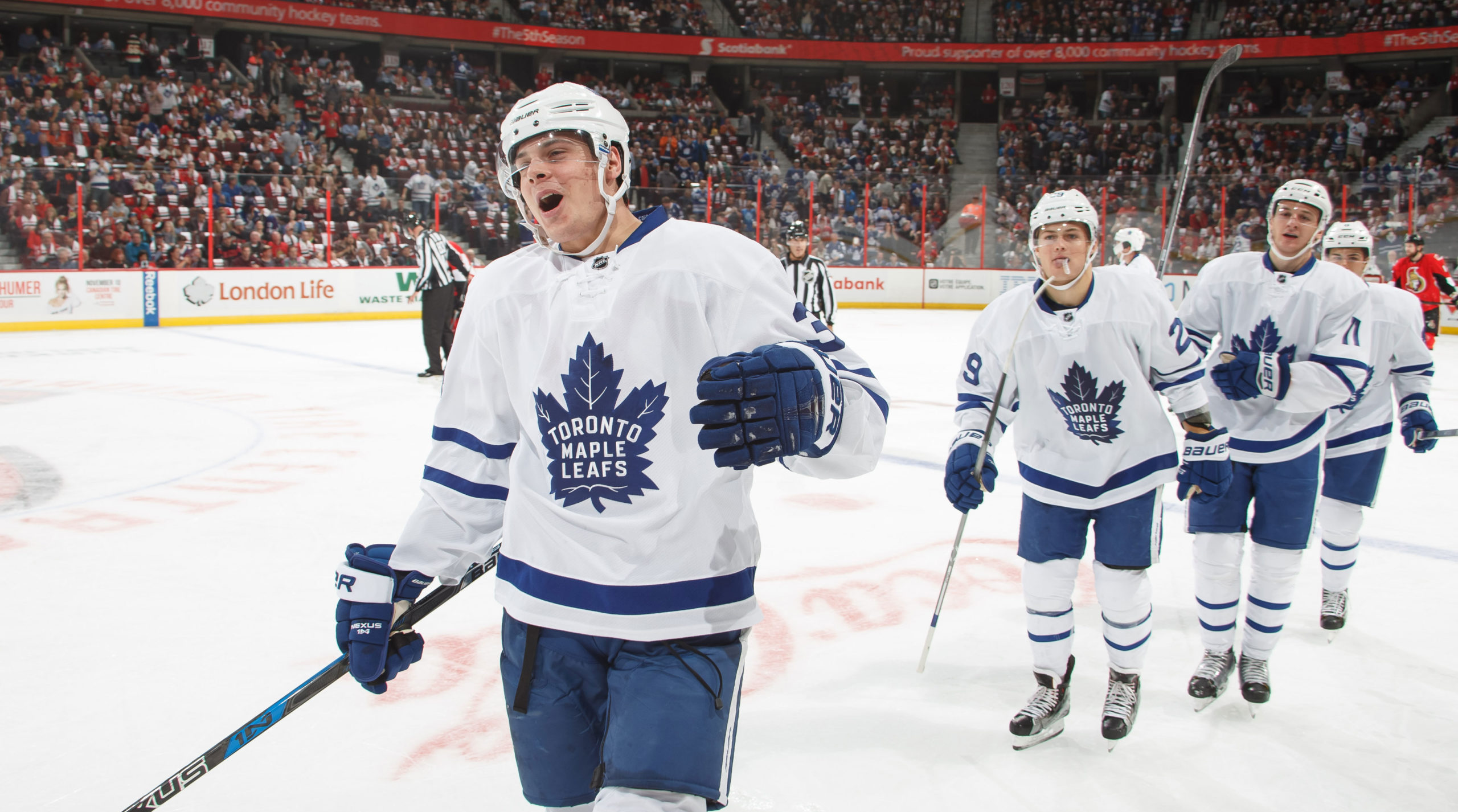




![Sheldon Keefe on the Maple Leafs’ struggling power play: “[We’ve scored] one out of 11 high-danger chances in tight to the net… We have been in those spots and haven’t converted” Sheldon Keefe, playoff press conference](https://mapleleafshotstove.com/wp-content/uploads/2024/04/keefe-pc-game-3-100x70.jpg)



![Jim Montgomery Post Game, Bruins 4 vs. Leafs 2: “[Marchand] still manages to get under people’s skin, yet he doesn’t cross the line” Jim Montgomery, Boston Bruins post game](https://mapleleafshotstove.com/wp-content/uploads/2024/04/jim-monty-pg-to-100x70.jpg)
